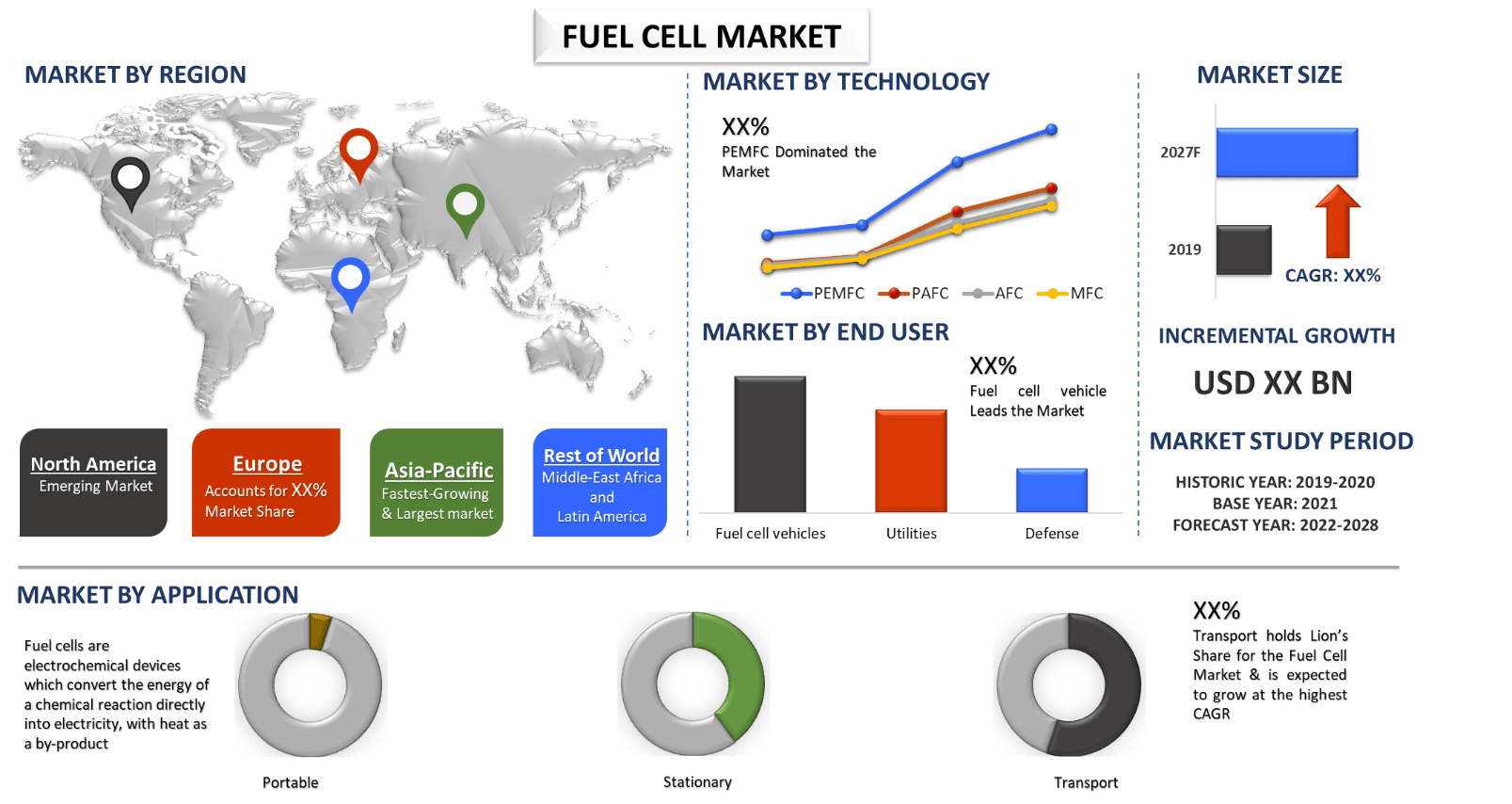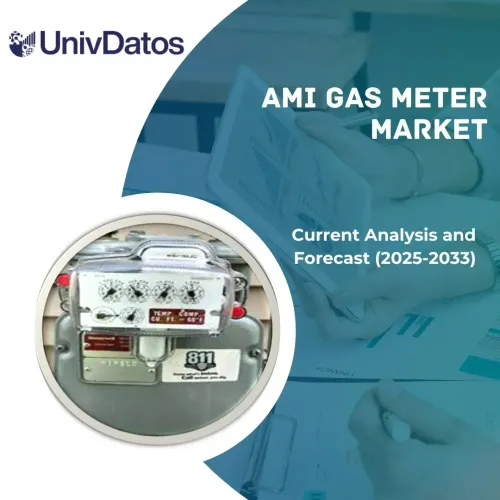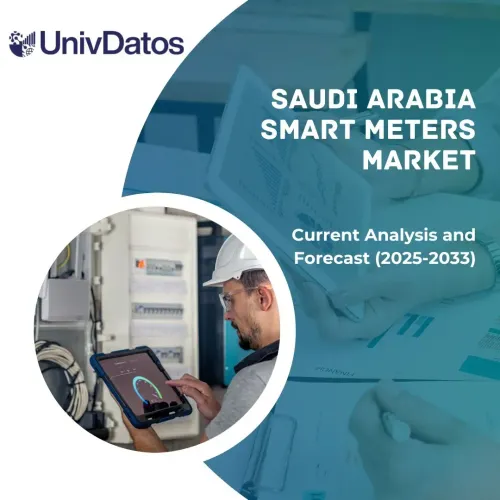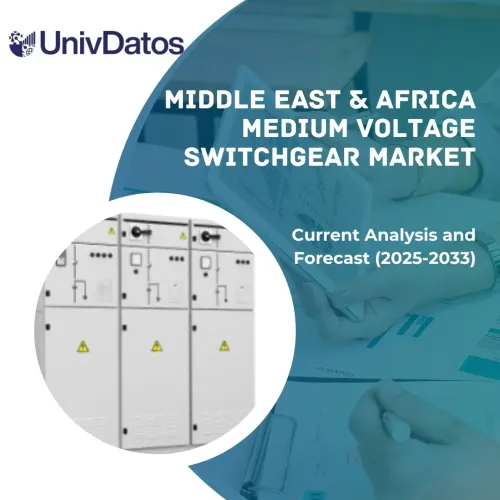- Home
- About Us
- Industry
- Services
- Reading
- Contact Us
Fuel Cell Market: Current Analysis and Forecast (2021-2027)
Emphasis on Technology Type (Proton Exchange Membrane Fuel Cell (PEMFC), Phosphoric Acid Fuel Cell (PAFC), Alkaline Fuel Cell (AFC), Microbial Fuel Cell (MFC)); Application Type (Transport, Portable & Stationary); End-User (Fuel cell vehicles, Utilities, Defense); Region and Country

Fuel Cell Market was valued at US$ 3.5 billion in 2020 and is expected to grow at a CAGR of 20% over the forecast period (2021-2027). Fuel cells are electrochemical devices which convert the energy of a chemical reaction directly into electricity, with heat as a by-product. They are similar in principle to primary batteries except that the fuel and oxidant are stored externally, enabling them to continue operating as long as fuel and oxidant (oxygen or air) are supplied. Fuel cells are a rapidly developing energy conversion technology offering higher efficiencies than conventional technologies, they also operate quietly and have a modular construction that is easily scalable. The growth of Fuel Cell Market expanded significantly over recent years, underpinned by increasing GHG emissions, rising demand for fuel cell electric vehicles, and increasing public interest in sustainable and environmentally friendly products. For instance, as per IEA, 34,804 fuel cell vehicles (FCVs) of all types were in operation worldwide as of the end of 2020.
Other factor driving the growth of the Fuel Cell Market globally are high focus of the governments worldwide on the utilization of clean energy sources which has led to an increase in the overall investments in generating electricity using fuel cells. Also, Fuel cell technology, with its ability to replace traditional power generating technologies based on combustion methods for stationary and mobile applications, is being promoted as a new clean and green power generation approach.
Ballard Power Systems, Cummins Inc., Horizon Fuel Cell Technologies, SFC Energy AG, Mitsubishi Power, Ltd. Bloom Energy etc. are some of the prominent players operating in the Global Fuel Cell Market. Several M&As along with partnerships have been undertaken by these players to facilitate countries with more innovative Fuel Cell applications.
Insights Presented in the Report
“Amongst technology type, Proton Exchange Membrane Fuel Cell (PEMFC) segment holds the major share.”
Based on technology type, the market is segmented into Proton Exchange Membrane Fuel Cell (PEMFC), Phosphoric Acid Fuel Cell (PAFC), Alkaline Fuel Cell (AFC) and Microbial Fuel Cell (MFC). The Proton Exchange Membrane Fuel Cell (PEMFC) segment grabbed XX% market share of the Global Fuel Cell Market and gathered revenue of USD XX billion in 2020. The segment is expected to grow at a CAGR of XX% during the forecast period to reach a market valuation of USD XX billion by 2027 owing to its high efficiency, low operational cost, quick maintenance, and enhanced reliability and operability.
“Amongst application type, Transport segment dominated the market in 2020.”
Based on application, the market is segmented into Transport, Portable & Stationary. In 2020, the transport segment dominated the Fuel Cell Market and accounted for XX% market share. This segment will witness a considerable CAGR of XX% during the forecast period (2021-2027F) owing to widespread usage of fuel cell technology in heavy-duty operations such as public transport in regions such as Asia Pacific.
“Amongst End User type, Fuel Cell Vehicle segment dominated the market in 2020.”
Based on end user, the market is classified into Fuel cell vehicles, Utilities and Defense. The fuel cell vehicle segment generated revenue of USD XX billion in 2020. The segment is expected to grow at a CAGR of XX% during the forecast period to reach a market valuation of USD XX billion by 2027. This segment will witness a considerable CAGR of XX% during the forecast period (2021-2027F) owing to its higher performance, reduced refueling time, and long-range offered by the systems.
“Asia Pacific represents as the largest market in the Global Fuel Cell Market.”
For a better understanding of the market adoption of Fuel Cell, the market is analyzed based on its worldwide presence in the countries such as North America (United States, Canada, Rest of North America), Europe (Germany, France, Italy, Spain, United Kingdom, Norway, and Rest of Europe), Asia-Pacific (China, Japan, India, Australia, South Korea, and Rest of APAC), and Rest of World. Asia Pacific constitutes the largest market for the industry and generated revenue of USD XX billion in 2020 on account of the growing automotive industry & favorable government policies in countries, such as China, Japan, and South Korea, which are driving clean energy usage.
Reasons to buy this report:
- The study includes market sizing and forecasting analysis validated by authenticated key industry experts
- The report presents a quick review of overall industry performance at one glance
- The report covers an in-depth analysis of prominent industry peers with a primary focus on key business financials, product portfolio, expansion strategies, and recent developments
- Detailed examination of drivers, restraints, key trends, and opportunities prevailing in the industry
- The study comprehensively covers the market across different segments
- Deep dive regional & country-level analysis of the industry
Customization Options:
The Global Fuel Cell Market can further be customized as per the requirement or any other market segment. Besides this, UMI understands that you may have your own business needs, hence feel free to connect with us to get a report that completely suits your requirements.
Table of Content
Analyzing the historical market, estimation of the current market, and forecasting the future of the Global Fuel Cell were the three major steps undertaken to create and analyze the adoption of Fuel Cell across various segments in North America, Europe, Asia Pacific, & Rest of the world. Exhaustive secondary research was conducted to collect the historical market numbers and estimate the current market size. Secondly, to validate these insights, numerous findings and assumptions were taken into consideration. Moreover, exhaustive primary interviews were also conducted, with industry experts across the value chain of the Fuel Cell sector. Post assumption and validation of market numbers through primary interviews, we employed a bottom-up approach to forecast the complete market size. Thereafter, market breakdown and data triangulation methods were adopted to estimate and analyze the market size of segments and sub-segments the industry pertains to. Detailed methodology is explained below:
Analysis of Historical Market Size
Step 1: In-Depth Study of Secondary Sources:
Detailed secondary study was conducted to obtain the historical market size of the Fuel Cell through company internal sources such as annual report & financial statements, performance presentations, press releases, etc., and external sources including journals, news & articles, government publications, competitor publications, sector reports, third-party database, and other credible publications.
Step 2: Market Segmentation:
After obtaining the historical market size of the Fuel Cell Market, we conducted a detailed secondary analysis to gather historical market insights and share for different segments & sub-segments for major regions. Major segments included in the report are as technology type, application, and end user. Further regional & country-level analyses were conducted to evaluate the overall adoption of the Fuel Cell in the global context.
Step 3: Factor Analysis:
After acquiring the historical market size of different segments and sub-segments, we conducted a detailed factor analysis to estimate the current market size of Fuel Cell. Further, we conducted factor analysis using dependent and independent variables like burgeoning global warming rates and global need for clean energy sources like fuel cell. Historical trends and their year-on-year impact on the market size and share in the recent past was analyzed. Demand and supply side scenario was also thoroughly studied.
Current Market Size Estimate & Forecast
Current Market Sizing: Based on actionable insights from the above 3 steps, we arrived at the current market size, key players in the Global Fuel Cell Market, and market shares of the segments. All the required percentage split, and market breakdowns were determined using the above-mentioned secondary approach and were verified through primary interviews.
Estimation & Forecasting: For market estimation and forecast, weights were assigned to different factors including drivers & trends, restraints, and opportunities available for the stakeholders. After analyzing these factors, relevant forecasting techniques i.e., bottom-up approach was applied to arrive at the market forecast to 2027 for different segments and subsegments across the major regions globally. The research methodology adopted to estimate the market size encompasses:
- The industry’s market size, in terms of value (US$) and the adoption rate of Fuel Cell across the major markets
- All percentage shares, splits, and breakdowns of market segments and sub-segments
- Key players in the Fuel Cell Market in terms of services offered. Also, the growth strategies adopted by these players to compete in the fast-growing market.
Market Size and Share Validation
Primary Research: In-depth interviews were conducted with the Key Opinion Leaders (KOLs) including Top Level Executives (CXO/VPs, Sales Head, Marketing Head, Operational Head, and Regional Head, Country Head, etc.) across major countries. Primary research findings were then summarized, and statistical analysis was performed to prove the stated hypothesis. Inputs from primary research were consolidated with secondary findings, hence turning information into actionable insights.
Split of Primary Participants in Different Regions
Market Engineering
Data triangulation technique was employed to complete the overall market estimation and to arrive at precise statistical numbers of each segment and sub-segment of the Global Fuel Cell Market. Data was split into several segments & sub-segments post studying various parameters and trends in the areas of technology type, application, and end user verticals.
The main objective of the Fuel Cell Market Study
The current & future market trends of Fuel Cell were pinpointed in the study. Investors can gain strategic insights to base their discretion for investments from the qualitative and quantitative analysis performed in the study. Current and future market trends determine the overall attractiveness of the market at a global & country level, providing a platform for the industrial participant to exploit the untapped market to benefit as a first-mover advantage. Other quantitative goals of the studies include:
- Analyze the current and forecast market size of Fuel Cell in terms of value (US$). Also, analyze the current and forecast market size of different segments and sub-segments
- Segments in the study include areas of technology type, application, and end user verticals
- Defined analysis of the regulatory framework for the Global Fuel Cell industry
- Analyze the value chain involved with the presence of various intermediaries, along with analyzing customer and competitor behaviors of the industry
- Analyze the current and forecast market size of the Fuel Cell for the major regions & countries
- Major regions studied in the report include North America, Europe, Asia Pacific, and Rest of World
- Company profiles of the Fuel Cell Market players and the growth strategies adopted by them to sustain in the fast-growing market
- Deep dive regional & country level analysis of the industry
Related Reports
Customers who bought this item also bought











